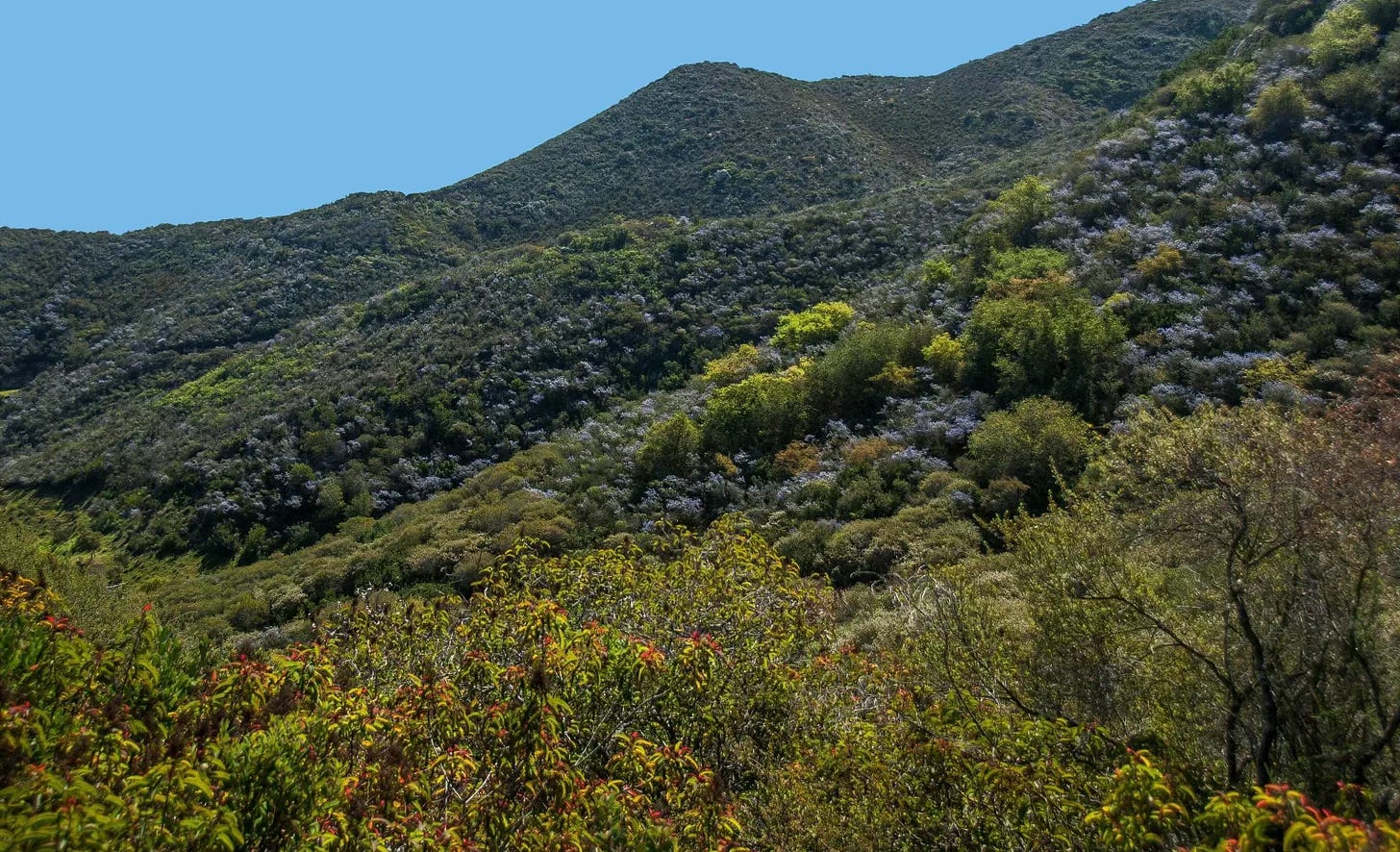In touch: Chaparral
The LA fires focused attention on the brush surrounding the city. Let's take a closer look
The eyes of the entire world were focused on Los Angeles in January 2025, as neighborhoods of the city were lost in conflagrations. While much of the reporting of these fires described the landscapes surrounding the burning communities as just brush or, incorrectly, forest, they are correctly identified as a mixture of coastal sage, chaparral, and invasive grasses and forbs.
As there is a great deal of misunderstanding about these plant communities, I thought I’d take this opportunity to clarify and explain what chaparral is and share my appreciation of this marvelous bit of California’s splendor. If you’re interested in coastal sage, there is my “In Touch” from December 27th on the topic.
Walking through coastal sage can be delightful. Particularly after a good rain, the aromas of the sages can be quite pleasant. The same excursion through chaparral presents wonders all its own. First off, chaparral is not a single type of plant community. Around where I live, it can vary from tall stands of scrub oaks and mountain mahogany, sometimes reaching 15 feet or higher. Stands such as these can be found at Torrey Pines State Reserve, just north of San Diego. A hike around Ramona, about 20 miles east of San Diego, can take you through hillsides dominated by chamise, which might remind folks of miniature pines with their short, needle-like leaves. Another 20 miles east, where the Laguna Mountains can reach over 5,000 feet, you may walk through stands of big berry manzanita, their twisty, red branches ending in slate green leaves and creamy pink flowers.
The big berry is just one species of manzanita. I could write a whole post about manzanita. Calscape lists 180 species of the plant in California. Some are quite adaptable, their habitat stretching the length of the state, while others are more restricted in range. The crinite manzanita mostly hugs the shores of the San Francisco Bay area, and the Del Mar manzanita only grows in the sandstone soils around the coastal city of Del Mar. Manzanita, like scrub oaks, mountain mahogany, chamise, and other plants all thrive in chaparral.
From Oregon south past the border with Mexico, chapparal evolved in California’s Mediterranean climate of wet winters—as little as 10 inches along our coasts to as much as 40 inches in our mountains—followed by drought conditions for the warmer months of the year. In the fall, the dry Santa Ana winds come, creating ideal wildfire conditions as they whip over landscapes that have dried for six months.
Historically, without humans and our cigarettes and electrical lines to start ignitions, fires were less common, but they did happen. The chaparral plants evolved strategies to survive and even thrive in these conditions. Fires usually consume all above-ground vegetation when chaparral burns. Some plants, like the hoary leaf ceanothus, produce seeds that build up in soils over decades. Once a fire comes through, the heat germinates those seeds and they are ready to sprout wherever flames have cleared space for them.
Other plants, such as red shanks, rely on their roots or an underground burl to survive fire and resprout soon after flames have swept through a landscape. Some manzanita species and a few other plants rely on both strategies of resprouting after fire and having seeds germinated by fire.
Chaparral can also play a part in a forest’s regeneration after a fire. When fires tore through Southern California in 2003 and 2007, some pine forests were thoroughly charred, with no trees surviving. In a matter of months, however, several species of ceanothus sprouted and blanketed the valleys and mountains where the pines had once been. As I was hiking with a friend through these areas recently, we both noted, 18 years after the fires, that these stands of ceanothus are now home to returning pines. In several years, if conditions don’t change because of global warming or other disruptions, the natural succession will see more and more pines and fewer ceanothus until these acres are once again a pine-dominated forest.
Fire is part of the ecology of chaparral, but too much fire can lead to the chaparral being replaced by invasive, nonnative grasses. Because of human ignition, fires can recur in chaparral in as few as three years, not enough time for the shrubs and trees to reach maturity and produce flowers and seeds. In their absence, annual grasses and nonnative forbs take over. This process is called “type conversion.”

This is another reason why prescribed burns of chaparral are not recommended. These deliberate fires only aide in the type conversion to nonnative grasses. Unfortunately, in this last election, Californians approved Proposition 4, which would allow for the clearing of and prescribed burns of chaparral in the name of fire safety. As well, right-wing political organizations have politicized the issue and are promoting prescribed burns of California’s landscapes.
Chaparral, as overlooked and misunderstood as it might be, is quite possibly the most famous plant community in the world. Covering the mountains and valleys around Hollywood, moviemakers and television producers have used chaparral as backdrop for countless outdoor scenes. Captain Kirk and Mr. Spock walked on alien planets covered in chaparral and coastal sage scrub. World War II movies would have you believe that chaparral covers the landscapes of Italy and Germany. Below, The Dukes of Hazzard, pretending to be the hills and hollows of Kentucky, are actually the chaparral covered environs around Los Angeles.
Now that you know a little about chaparral, can you name a movie or TV show where you can see chaparral?
You can find me on social media at: paul4earth.bsky.social




And after the pines come??? I guess we never reach that stage anymore.
Informative post!